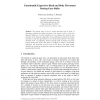Free Online Productivity Tools
i2Speak
i2Symbol
i2OCR
iTex2Img
iWeb2Print
iWeb2Shot
i2Type
iPdf2Split
iPdf2Merge
i2Bopomofo
i2Arabic
i2Style
i2Image
i2PDF
iLatex2Rtf
Sci2ools
IVA
2007
Springer
2007
Springer
Emotionally Expressive Head and Body Movement During Gaze Shifts
The current state of the art virtual characters fall far short of characters produced by skilled animators. One reason for this is that the physical behaviors of virtual characters do not express the emotions and attitudes of the character adequately. A key deficiency possessed by virtual characters is that their gaze behavior is not emotionally expressive. This paper describes work on expressing emotion through head movement and body posture during gaze shifts, with intent to integrate a model of emotionally expressive eye movement into this work in the future. The paper further describes an evaluation showing that users can recognize the emotional states generated by the model.
| Added | 08 Jun 2010 |
| Updated | 08 Jun 2010 |
| Type | Conference |
| Year | 2007 |
| Where | IVA |
| Authors | Brent Lance, Stacy Marsella |
Comments (0)

